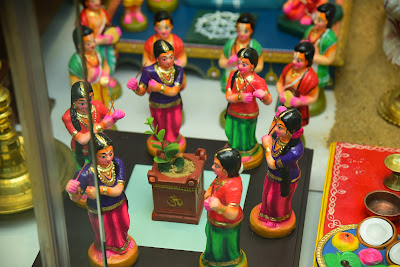We at Ramsons Bombe Mane have not come across any evidence regarding the history or background story about Bombe Habba. There are three theories, as told by some practitioners of Bombe Habba, as follows...
Theory 1: It is only during the 10 days of Sharan Navaratri that Mysore Maharaja ascends and sits on the golden throne - Karnataka Ratna Simhasana. Every time, before ascending the throne, he performs ritual worship to it. Every Mysorean wants to invite Maharaja to their home and pay respects to him in the form of Pada Puja. But since it is Navaratri, Maharaja has ritually committed (Kankana Bandhana) with a vow (sankalpa) to perform the Navaratri puja. So he cannot step out of the Palace during the nine plus one day until Seemollanghana. Hence as a representative of the king and the queen, the Pattada Bombe (pair of Raja Rani dolls made out of either wood, clay, cloth, metal or ivory) are worshipped during Navaratri / Dasara in many Mysore households. A stepped platform, representing the stepped golden throne, is assembled in one of the spacious rooms in the house and the Pattada Bombe are placed on the top-most tier. Other dolls in the form of deities, important personalities, animals, birds and toys are placed on the other steps of this Bombe Mettilu. Usually Bombe Mettilu consists of odd number of steps, say three, five, seven or nine. More number of steps will be added as the doll collection expands over years.
So paying respect to the royal couple is the first theory for Bombe Habba.
Theory 2: As per another theory, dolls represent our ancestors. Sharan Navaratri starts just as the fifteen days of Pitru Paksha ends and it is believed that our ancestors (Pitrus) descend to earth from their Pitru Loka during Pitru Paksha. There is a belief that dolls represent our ancestors and hence after the Pitru Paksha the dolls representing the ancestors are assembled neatly on a stepped platform and offered worship for nine days. After fifteen days from Navaratri during Deepavali, we light crackers and sky lanterns to show our ancestors way back to their abode. So the journey of our ancestors that starts from Pitru Paksha ends on Deepavali.
Theory 3: The third theory is interesting. The golden throne of Mysore is believed to have been come down from Pandavas. It was lost in time and found by Raja Bhoja of Ujjain under a mound of earth. It is said that the throne which belonged to Raja Vikramaditya was made of gold and was decorated with thirty-two dolls. It was excavated and on an auspicious day and time, Bhoja Raja tried to ascend the throne. As soon as he placed his foot on the first step of the throne, one of the dolls became alive, stopped the king from stepping further. It narrated a noble story of Raja Vikramaditya to whom the throne belonged earlier, and asked Bhoja whether he was worthy enough to ascend the throne. Disappointed with the answer, the doll flew away to heaven. The king tried to ascend the throne again the next day. The story repeated and one more doll flew away. Like wise, all the thirty-two dolls fly away to heaven. This is the famous story of Singhasan Battisi.
The Bombe Mettilu of Navaratri peopled with the dolls represent this holy throne of Pandavas.
























































